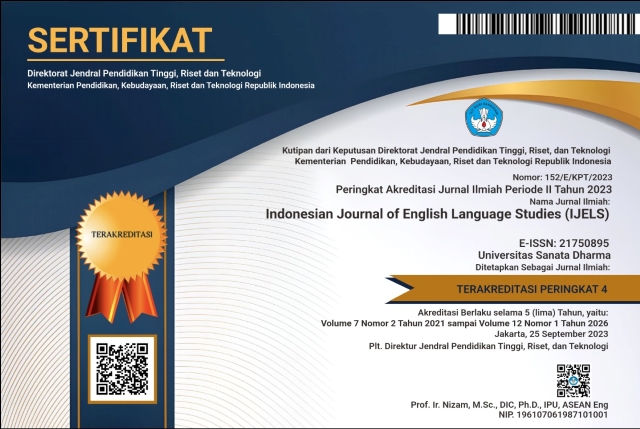English Passive Voice: An X-Bar Theory Analysis
(1)
(*) Corresponding Author
Abstract
English passive voice has its own pattern. Some says that the pattern comes from the active form then it is changing. However, it is rather difficult to memorize the pattern, especially for the non-native people. X-bar theory is one way that can be used in understanding the passive form. By using X-bar diagram, the D- structure of the sentence can be seen and then moved into certain position which makes the S-structure of passive form. This study aims to see what movements exist in the English passive constructions and if there is any of special case. By giving the examples and the X-bar diagrams of basic form of passive, passive form of fu- ture tense, passive form of continuous tense, the special case inserting the word ‘by’, and also the use of word ‘get’; the construction of passive form will be clearly and easily understood.
Keywords
Full Text:
PDFReferences
Al Aqad, M. H. (2013). Syntactic Analysis of Arabic Adverbs Between Arabic and English: X-bar Theory. International Journal of Language and Linguistics, 70-74.
Azar, B. S. (2003). Fundamentals of English Grammar. New York: Pearson Education.
Baltin, M., & Collins, C. (2001). The Handbook of Contemporary Syntactic Theory. Oxfrod: Blackwell Publishers.
Borsley, R. D. (1999). Syntactic Theory, A Unified Approach. London: Arnold Publishers.
Dwijatmoko, B.B. (2002). English Syntax. Yogyakarta: Sanata Dharma Univesity Press.
Fanselow, G., & Lenertova, D. (2011). Left Peripheral Focus: Mismatches between Syntax and Information Structure. Natural Language & Linguist Theory Vol. 29, No.1, 169-209.
Mondorf, B. (2012). Review of Deconstructing the English Passive. Language, Vol. 88 No. 2, 452-457.
Radford, A. (2009). An Introduction to English Sentence Structure. Cambridge: Cambridge University Press.
Siewierska, A. (1984). The Passive, A Comparative Linguistic Analysis. Sydney: Croom Helm Ltd.
DOI: https://doi.org/10.24071/ijels.v4i2.2305
Refbacks
- There are currently no refbacks.

This work is licensed under a Creative Commons Attribution-ShareAlike 4.0 International License.
IJELS Journal Sinta 4 Certificate (S4 = Level 4)
We would like to inform you that Indonesian Journal of English Language Studies (IJELS) has been nationally accredited Sinta 4 by the Ministry of Education, Culture, Research and Technology of the Republic of Indonesia based on the decree No. Surat Keputusan 152/E/KPT/2023. Validity for 5 years: Vol 7 No 2, 2021 till Vol 12 No 1, 2026

This work is licensed under CC BY-SA.
Creative Commons Attribution-ShareAlike 4.0 International License
IJELS e-ISSN 2715-0895; IJELS p-ISSN 2442-790X
Indonesian Journal of English Language Studies (IJELS) is published twice a year, namely in March and September, by the English Language Studies (ELS) of the Graduate Program of Sanata Dharma University, Yogyakarta, Indonesia.


 IJELS p-ISSN:
IJELS p-ISSN: 









